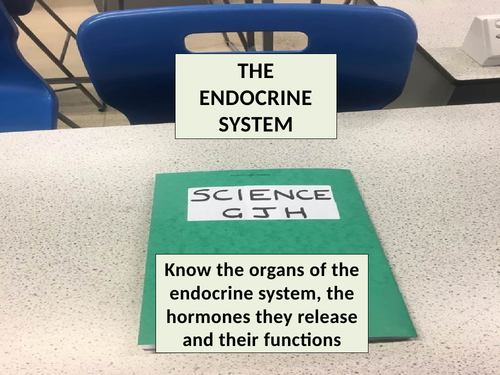


An engaging lesson presentation which looks at the organs of the human endocrine system, the hormones they release and briefly considers some of their functions. This lesson has been designed for GCSE students but could be used with younger students at KS3 who are studying the different organ systems in the human body.
The lesson begins by looking at the meaning of endo and crine so that students recognise that this is also known as the hormonal system and the hormones are always released directly into the blood. A number of quick competitions have been written into the lesson to maintain engagement and provide opportunities to check understanding in an alternative way to simple questions. This first of these games is called “Any sign of the ENDOCRINE”, where students are challenged to pick the endocrine gland out of a selection of three and then come to board to point to where it would be found on a body outline. The students have to label the diagram on the worksheet included in this lesson and then allocate hormones to 5 of the 6 glands. Time is taken to focus on the pituitary gland and three of the hormones that it releases in FSH, LH and TSH because these relate to the menstrual cycle and the thyroid gland. The final part of the lesson involves students being shown an acronym, HBGT, that they can use in longer answers to ensure that they mention the hormone, blood, the gland that releases the hormone and the target tissue.
Get this resource as part of a bundle and save up to 30%
A bundle is a package of resources grouped together to teach a particular topic, or a series of lessons, in one place.
Topic B3.2: Coordination and control - the endocrine system (OCR Gateway A GCSE Combined Science)
This bundle of 7 lessons covers all of the content in the sub-topic B3.2 (Coordination and control - the endocrine system) of the OCR Gateway A GCSE Combined Science specification. The topics and specification points covered within these lessons include: Describe hormonal coordination by the human endocrine system Explain the roles of adrenaline and thyroxine in the body Describe the role of hormones in human reproduction (the menstrual cycle) The hormonal and non-hormonal methods of contraception Explain the use of hormones to treat infertility All of these lesson presentations and accompanying resources are detailed and engaging and contain regular progress checks to allow the students to constantly assess their understanding.
Topic B3: Organism-level systems (OCR Gateway A GCSE Biology)
This bundle of 15 lessons covers the majority of the content in Topic B3 (Organism level systems) of the OCR Gateway A GCSE Biology specification. The topics covered within these lessons include: The nervous system The eye Hormones and the endocrine system Adrenaline Negative feedback loops Thyroid gland and thyroxine The menstrual cycle Contraception Using hormones to treat infertility Plant hormones Homeostasis Controlling body temperature Controlling blood glucose Diabetes Inside the kidney All of these lesson presentations and accompanying resources are detailed and engaging and contain regular progress checks to allow the students to constantly assess their understanding.
Topic B3.2: The endocrine system (OCR Gateway A GCSE Biology)
This bundle of 9 lessons covers the majority of the content in the sub-topic B3.2 (The endocrine system) of the OCR Gateway A GCSE Biology specification. The topics covered within these lessons include: Hormones Negative feedback The menstrual cycle Controlling reproduction Using hormones to treat infertility Plant hormones All of these lesson presentations and accompanying resources are detailed and engaging and contain regular progress checks to allow the students to constantly assess their understanding
Topic B3: Organism level systems (OCR Gateway A GCSE Combined Science)
This bundle of 11 lessons covers the majority of the content in Topic B3 (Organism level systems) of the OCR Gateway A GCSE Combined Science specification. The topics covered within these lessons include: The nervous system Hormones and the endocrine system Adrenaline Negative feedback loops Thyroid gland and thyroxine The menstrual cycle Contraception Using hormones to treat infertility Homeostasis Controlling blood glucose Diabetes All of these lesson presentations and accompanying resources are detailed and engaging and contain regular progress checks to allow the students to constantly assess their understanding.
Topic B9: Coordination and response (Cambridge iGCSE Science Double Award)
This bundle of 9 lessons covers the majority of the content in Topic B9 (Coordination and response) of the core and supplement sections of the Cambridge iGCSE Science Double Award specification. The topics and specification points covered within these lessons include: The parts of the nervous system - CNS and PNS Identifiying sensory and motor neurones from diagrams The coordination of regulation of body functions Identifying the structures of the eye The functions of the parts of the eye Hormones as chemicals produced by glands The actions of adrenaline Homeostasis as the maintenance of a constant internal environment Control by negative feedback The control of blood glucose by the liver and insulin and glucagon from the pancreas The maintenance of a constant internal body temperature Phototropism, gravitropism and the involvement of auxins All of these lesson presentations and accompanying resources are detailed and engaging and contain regular progress checks to allow the students to constantly assess their understanding
Something went wrong, please try again later.
Great fun lesson. Thanks.
Report this resourceto let us know if it violates our terms and conditions.
Our customer service team will review your report and will be in touch.